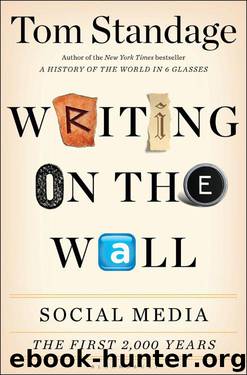Writing on the Wall: Social Media - The First 2,000 Years by Standage Tom

Author:Standage, Tom [Standage, Tom]
Language: eng
Format: epub, mobi
Publisher: Bloomsbury Publishing
Published: 2013-10-14T21:00:00+00:00
“THE ART OF PRINTING SHOULD is outwardly thIQ BE ENCOURAGED”
In May 1765 news reached the American colonies that the government in London had passed “an act for granting and applying certain Stamp Duties, and other Duties, in the British Colonies and Plantations in America, towards further defraying the Expenses of defending, protecting, and securing the same.” The British government had borrowed heavily to fund a war with the French around the world, which had been fought in Europe, the Americas, the Philippines, and parts of Africa and India. In Europe this conflict was known as the Seven Years’ War; in America, where French and English colonists fought each other with the backing of different Indian tribes, it was called the French and Indian War; and in retrospect it was arguably the first true world war. The government in London reasoned that having fought, in part, to protect its American colonists, it was only right that those colonists should pay some of the cost of defending their territory. The Stamp Act was intended to raise about one hundred thousand pounds a year, or a bit less than half the expected cost of maintaining a garrison in North America. Starting in November 1765, government-appointed agents would sell specially stamped paper. Legal documents that did not appear on paper marked with an appropriate stamp would not be considered binding by the courts, which would encourage compliance with the law, and it would be illegal to print newspapers or pamphlets on unstamped paper. From the point of view of the government in London, the merit of a stamp tax was that it would be relatively simple to administer and enforce.
The colonists saw things rather differently. The full text of the act was quickly reprinted in Philadelphia, Boston, Annapolis, New London, New York, and New Jersey. It could not have been better designed to antagonize lawyers, merchants, and printers, who were some of the most influential and outspoken members of society. Wills, property deeds, contracts, insurance policies, and other legal documents were subject to varying amounts of stamp duty; the tax was two pounds on a degree certificate, four pounds on a wine-seller’s permit, and ten pounds on a lawyer’s license. Printers would be required to pay a penny in tax for each sheet of paper used to print newspapers, and two shillings for every advertisement carried, roughly equivalent to a fifty-percent tax on advertising revenue. A similar tax was imposed on paper for printing pamphlets, increasing with the number of pages. Playing cards were to be taxed at a shilling a pack, and dice ten shillings. These taxes had to be paid with hard currency, rather than colonial paper currency.
All this would be inconvenient and costly, but it was also a direct attack on the colonists’ ability to exchange information with each other. Worst of all, it would force the colonists to pay taxes levied by a parliament in which they were not represented. A previous effort to tax the colonists by imposing duty
Download
Writing on the Wall: Social Media - The First 2,000 Years by Standage Tom.mobi
This site does not store any files on its server. We only index and link to content provided by other sites. Please contact the content providers to delete copyright contents if any and email us, we'll remove relevant links or contents immediately.
Cecilia; Or, Memoirs of an Heiress — Volume 1 by Fanny Burney(32440)
Cecilia; Or, Memoirs of an Heiress — Volume 2 by Fanny Burney(31875)
Cecilia; Or, Memoirs of an Heiress — Volume 3 by Fanny Burney(31858)
The Great Music City by Andrea Baker(31539)
We're Going to Need More Wine by Gabrielle Union(18973)
All the Missing Girls by Megan Miranda(15599)
Pimp by Iceberg Slim(14399)
Bombshells: Glamour Girls of a Lifetime by Sullivan Steve(13979)
Talking to Strangers by Malcolm Gladwell(13233)
Norse Mythology by Gaiman Neil(13217)
Fifty Shades Freed by E L James(13163)
For the Love of Europe by Rick Steves(13134)
Mindhunter: Inside the FBI's Elite Serial Crime Unit by John E. Douglas & Mark Olshaker(9212)
Crazy Rich Asians by Kevin Kwan(9174)
The Lost Art of Listening by Michael P. Nichols(7412)
Enlightenment Now: The Case for Reason, Science, Humanism, and Progress by Steven Pinker(7243)
The Four Agreements by Don Miguel Ruiz(6641)
Bad Blood by John Carreyrou(6559)
Weapons of Math Destruction by Cathy O'Neil(6152)
